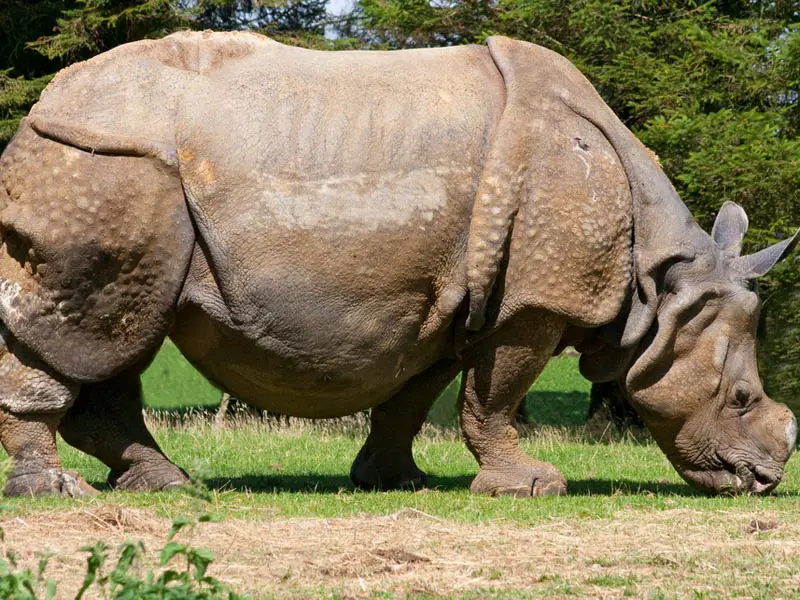The Indian rhinoceros (Rhinoceros unicornis) is a large rhino species native to the Indian Subcontinent. It is found in the riverine forest as well as alluvial grassland of India. IUCN Red List has listed Indian rhino as vulnerable for their range is limited to only 20,000 km2. The rhino is one of the largest terrestrial mammals in Asia—second only to Asian elephants.
Indian Rhinoceros Facts
Anatomy
- The Indian rhino is recognized by its thick folds of grey skin along with the black horn. These folds form the armor-like plates on the sides and neck. There are wart-like bumps on the rhino’s shoulders.
- Male rhinos have heavy skull which grows to length of 60 cm (24 in).
- Both males and females have a single horn. The horn is 25 cm (9.8 in) long with the longest length recorded up to 57.2 cm (22.5 in).
- The Indian rhino is also second largest rhinoceros—behind only the white rhinoceros.
- The head-body length of male rhinos is up to 368–380 cm (12.07–12.47 ft) and it stands 148–173 cm (4.86–5.68 ft) at the shoulder.
- Female rhinos stand 63 in (160 cm) at the shoulder. The head-body length is up to 135 in (340 cm).
- Adult males average 2,200 kg (4,900 lb) in weight.
- The heaviest rhinoceros ever recorded up to 4,000 kg (8,800 lb).
Distribution
- Indian rhinoceros occurs in the northern India, northern Burma and in some parts of Bhutan and Nepal.
- Currently it is limited to the only isolated reserves of Assam, Bhutan and Nepal.
- In India, rhinos are distributed in the Ganges River, Brahmaputra River and Indus River.
- An isolated population is also found in Indochina, Myanmar, and southern China.
Read More: What Do Rhinos Eat in the Wild?

Habitat
They would like to make homes in swamp-like habitats, woodlands, floodplains, or drier ground that are abundant in cane-like grasses. The grasses may be as tall as 13–20 ft (4–6 m).
Behavior
- Indian rhinoceros is a solitary animal outside the breeding season. The home range is 2 to 8 km2 (0.77 to 3.09 sq mi).
- Males have a range of 1.1–1.5 mi2 (3–4 km2)
- Dominant males will not tolerate other males during the breeding season. There is a chance that violent fight might take place which could lead to fatal injuries. However outside the breeding days, they may not notice other males passing through.
- Rhinos go active either early in the morning or at night. They are known to spend 50 – 65% of their time on feeding.
- They are thought to spend the midday in ponds, lakes, puddles, and rivers.
- They produce 10 different calls. Their calls include squeaks, grunts, loud roars, shrieking, groaning, bleating, and
- While adult rhinos don’t have any natural predators calves do. Calves may fall victim to tigers.
- In short bursts, Indian rhinos can reach a speed of 55 km/h (34 mph).
- They are remarkable swimmers.
- Like other rhinos, Indian rhinoceros has poor eyesight but an excellent sense of smell and hearing.
- They form groups of up to 10 animals.
Feeding Ecology & Diet
- Indian rhinos are regular browsers because they have got finger-like upper lip that is typically used to grip stems, bushes and grass.
- Rhino folds its upper lip when it is going to graze short grasses. Saccharum forms the principal food all year-round.
- During the monsoon period, they like to consume short herbs and grasses as well as aquatic plants. Rhino will also eat hard green fruits of Trewia nudiflora especially those that fall down to the ground.
- In winter, Indian rhinos rely on woody browse.
Reproductive Biology
- The mating typically occurs in the monsoon season at Chitwan. A female produces whistling sounds sometimes make honking sound.
- The gestation period lasts about 16 months. Females will find forest or thick grassland to give birth. During this time, female rhinos go very aggressive against other males.
- Calves weigh up to 140–150 lb (65–70 kg). The mother will go out and search some food while the calves stay behind for up to an hour. This continues for about 2 months. The mother travels hundred feet away.
- The mother continues to nurse calves until they reach 2 year age.
- In the wild the female attains maturity from 6 to 8 years of age. The captive rhinos however become mature in 3 years age.
- The birth interval is 3.5 – 4.0 years.
- In captivity the maximum lifespan is recorded up to 47 years while in the wild they live up to 30 years.
- Young under eight months are far more vulnerable to tigers.
Conservation Status
- There are 3,555 rhinos remaining in the wild.
- IUCN Red List has listed Indian rhinos as vulnerable species.
More: Rhino Facts for Kids





